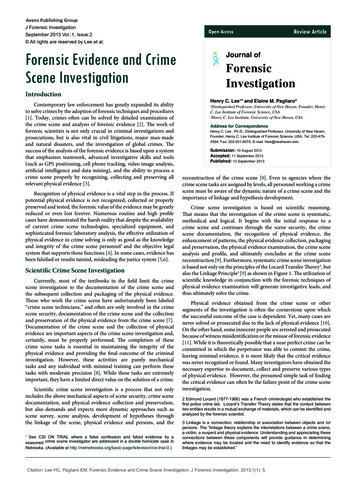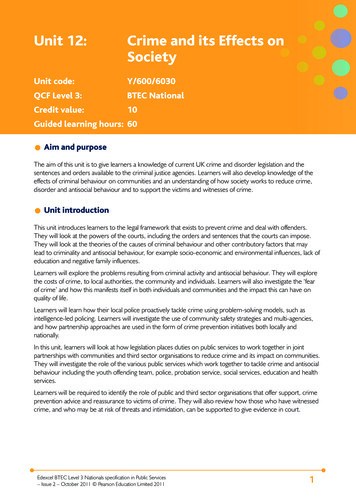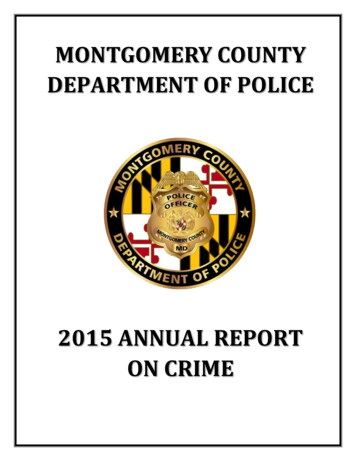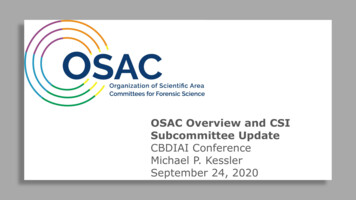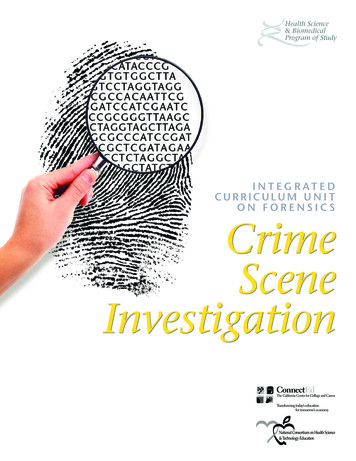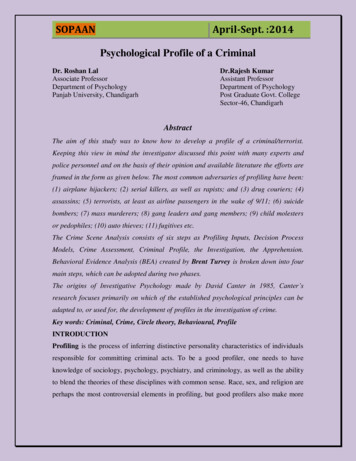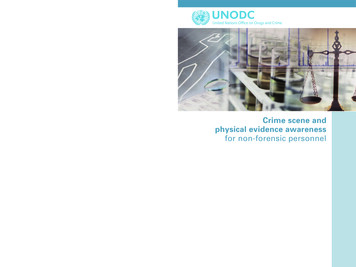
Transcription
Vienna International Centre, PO Box 500, 1400 Vienna, AustriaTel.: ( 43-1) 26060-0, Fax: ( 43-1) 26060-5866, www.unodc.orgCrime scene andphysical evidence awarenessfor non-forensic personnelFOR UNITED NATIONS USE ONLYUnited Nations publicationSales No. E.09.IV.5ISBN 978-92-1-130273-8ST/NAR/39Printedin Austria*0981977*V.09-81977—April 2009—1,140
Photo credits:UNODC Photo Library
Laboratory and Scientific SectionUnited Nations Office on Drugs and CrimeViennaCrime scene and physical evidenceawareness for non-forensic personnelUNITED NATIONSNew York, 2009
Wherever he steps, whatever he touches, whatever he leaves, even unconsciously, willserve as silent evidence against him. Not only his fingerprints or his footprints, but hishair, the fibers from his clothes, the glass he breaks, the tool mark he leaves, the painthe scratches, the blood or semen he deposits or collects - all these and more bear mutewitness against him. This is evidence that does not forget. It is not confused by theexcitement of the moment. It is not absent because human witnesses are. It is factualevidence. Physical evidence cannot be wrong; it cannot perjure itself; it cannot bewholly absent. Only its interpretation can err. Only human failure to find it, study andunderstand it, can diminish its value.Kirk, Paul,Crime investigation,John Wiley & Sons Canada, Limited, 1953ST/NAR/39UNITED NATIONS PUBLICATIONSales No. E.09.IV.5ISBN 978-92-1-130273-8This publication has not been formally edited.
AcknowledgementsivIntroduction and purpose1PART IThe value of physical evidence and the conceptof chain-of-custody4Forensic science services and the crime scene investigationprocess4Legal, ethical and human dignity considerations5Health and safety considerations6PART IIPlanning, organization and coordination of the workat the scene8Preservation of the scene and its evidence10Documentation of the scene and its evidence12Recognition, recovery and preservation of physical evidence13Transportation, storage and submission of evidenceto the laboratory15Annex—Types of physical evidence potentially presentat crime scenes, and their evidential value17iii
ACKNOWLEDGEMENTSThis manual was conceptualized by the Laboratory and Scientific Section (LSS) ofthe United Nations Office on Drugs and Crime (UNODC) with inputs from the International Committee for the Red Cross (ICRC) and the Office of the United Nations HighCommissioner for Human Rights (OHCHR).The development of this manual would not have been possible without the valuablecontributions, at different stages of the process, of the following experts. To them,UNODC wish to express its appreciation and thanks:Joseph ALMOG, Professor of Forensic Chemistry, Hebrew University of Jerusalem, IsraelChristina BERTLER, Senior Adviser, SKL (Statens kriminaltekniska laboratorium), SwedenBob BRAMLEY, Formerly chief scientist of the FSS (Forensic Science Service),United KingdomDavid CLARKE, Former Government Chemist, Government Laboratory, Hong Kong, ChinaRainer DAHLENBURG, Forensic Consultant, Afghanistan Country Office,UNODC and Forensic Chemist, BKA (Bundeskriminalamt), GermanyPeter DE FOREST, Former Professor of Criminalistics, John Jay College of Criminal Justice,University of New York City, United StatesJan DE KINDER, Director, INCC/NICC (National Institute for Forensic Science andCriminology), BelgiumRamon DIAZ, Forensic Scientist, Criminalistics Laboratory, Institutes of Forensic Sciences,Puerto RicoBarry FISHER, Director, Los Angeles County Sheriff’s Department Crime Laboratory, UnitedStatesUte HOFMEISTER, Forensic Advisor, Assistance Division, ICRCMax HOUCK, Director, Forensic Science Initiative, West Virginia University, United StatesSusan JOHNS, Consultant, Susan Johns Forensic Consulting Inc, Illinois, United StatesChris LENNARD, External Scientific Advisor, Australian Federal Police and Professor ofForensic Studies, Faculty of Applied Science, University of Canberra, Australiaiv
SC LEUNG, Former Assistant Government Chemist / Former Chief, Government Laboratory,Forensic Science Division, Hong Kong, ChinaAdriano MALDANER, Director, Forensic Chemistry Laboratory, Federal Police, BrazilTofik MURSHUDLU, Project coordinator, Kazakhstan Project Office, UNODCSteve NASH, Past President and Crime Scene Certification Board member, InternationalAssociation for IdentificationAntoanela PAVLOVA, Human Rights Officer, Peace Missions Support and Rapid ResponseUnit, OHCHRPeter PFEFFERLI, Director, Forensic Science Division, Zurich Canton Police, SwitzerlandFlemming QUIST, Law Enforcement Advisor for Africa, Regional Office for Western andCentral Africa (ROSEN), UNODCTony RAYMOND, DNA Advancement Program Director and Acting Chief Scientist,Forensic Services Group, NSW Police Force, AustraliaRoberto RICCI, Chief, Peace Missions Support and Rapid Response Unit, OHCHRJames ROBERTSON, National Manager Forensic and Data Centres, Australian Federal Police,AustraliaNorah RUDIN, Forensic DNA Consultant, United StatesMorris TIDBALL-BINZ, Forensic Coordinator, Assistance Division, ICRCThe preparation of this manual was coordinated by Magali Bernard and Barbara Remberg, staffof the UNODC LSS (headed by Justice Tettey). The UNODC LSS is grateful to all other UNODCcolleagues who contributed to the manual.v
Every incident, be it a crime, accident, natural disaster, armed conflict, or other, leavestraces at the scene. The goal of the subsequent investigation is to correctly interpret thefacts, reconstruct the events and understand what happened.Due to the transient and fragile nature of those traces, their reliability and the preservationof their physical integrity depend to a very large extent on initial actions at the scene ofthe incident. Evidence integrity can be achieved with very limited means by observinga key set of guiding principles. Acting with care and professionalism throughout thecrime scene investigation process is critical for the admissibility of evidence for courtpurposes as well as for human rights inquiries and humanitarian action.The present manual was prepared to fill a gap in the compendium of available toolsfor the judiciary and law enforcement agencies and is the result of a consultative process involving a number of reputable individuals, institutions and organizations, whocontributed a variety of different perspectives to this cross-cutting issue, all groundedin the same basic principles common to all crime scenes.For the sake of simplicity, the term “crime scene” is used in this manual to refer to anyscene of incident that contains records of past activities.The manual aims at raising awareness of the importance of good practices in crimescene investigations and the nature and relevance of physical evidence. It covers issuesrelated to the work at the scene, from the actions of the first responder(s) to the submission of evidence to the laboratory. As such, it provides the very basis for enabling moreevidence-based reconstruction of events.The primary target audience of the manual is non-forensic personnel, i.e. first respondersand any person involved in the crime scene investigation process without full-fledgedtraining, to help them understand the importance of their actions and the consequencesof not applying basic principles of good practice. The manual also targets policymakers,the judiciary and others having to assess, and/or base decisions on evidence presentedto them.As an awareness-raising tool for non-forensic personnel, the manual provides a basicoutline of the crime scene investigation process with a focus on why individual stepsand actions are essential. An Annex provides examples of physical evidence that canbe recovered from crime scenes, the information that can be obtained from subsequentforensic examinations, and sample cases where different types of physical evidencemight be encountered.1
It is important to note that the manual is not a guide for crime scene investigations,neither for first responders nor for crime scene investigators. Detailed checklists andguidelines for preserving, documenting and processing crime scenes are availableelsewhere and should be consulted where practical, hands-on guidance for work at thecrime scene is required. Those guidelines are typically used in combination with training courses. Further advice should always be sought from local competent authoritiesand forensic scientists.2
3
4Crime scene and physical evidence awareness for non-forensic personnelThe value of physical evidenceand the concept of chain-of-custodyPhysical evidence can be anything from massive objects to microscopic items, generatedas part of a crime and recovered at the scene or at related locations.Considering all sources of information available in investigations (e.g. confessions,testimonies, video surveillance), physical evidence plays a pivotal and an especiallyvaluable role. With the exception of physical evidence, all other sources of informationsuffer from problems of limited reliability. Physical evidence, when it is recognized andproperly handled, offers the best prospect for providing objective and reliable information about the incident under investigation.However, the value of even the most carefully recovered and preserved evidence canbe lost if the chain-of-custody is not properly maintained. “Chain-of-custody” is oftenrecognized as the weak link in criminal investigations. It refers to the chronological andcareful documentation of evidence to establish its connection to an alleged crime. Fromthe beginning to the end of the forensic process, it is crucial to be able to demonstrateevery single step undertaken to ensure “traceability” and “continuity” of the evidencefrom the crime scene to the courtroom.Forensic science services and the crime sceneinvestigation processThe role of forensic science services starts at the crime scene with the recognition andrecovery of physical evidence. It proceeds with its analysis and the evaluation of theresults in a laboratory, and the presentation of the findings to judges, prosecutors, lawyersand others in need of the factual information. From the first responders to the end-usersof the information, all personnel involved should have an adequate understanding ofthe forensic process, the scientific disciplines and the specialized services provided byforensic laboratories.Crime scene investigation is a process that aims at recording the scene as it is firstencountered and recognizing and collecting all physical evidence potentially relevantto the solution of the case.The first responder(s), be they law enforcement officers, human rights officers or anyoneelse, play a critical role in the entire crime scene investigation process. Their initialresponsibilities are to preserve the integrity of the scene and the evidence. Furthermore,they are responsible for the early documentation of the crime scene, its evidence andall activities at the scene. As in the majority of cases first responders are non-forensicpersonnel, adequate training to carry out these tasks is critical.
Crime scene and physical evidence awareness for non-forensic personnel5Under ideal circumstances, crime scene investigators who have received full-fledgedforensic training quickly take over the work at the scene. However, there are situationsthat may require first responders (who are normally not expected to further process thescene) to carry out some basic recovery procedures before the arrival of the crime sceneinvestigators, if there is a risk of the evidence being destroyed, lost or contaminated.In situations where there is no prospect for the crime scene to be processed by crimescene investigators, the responsibilities of the first responder might have to be extendedbeyond preservation and documentation activities. These situations typically occur ifthe crime scene is in a remote location, if skilled crime scene investigators are not easilyavailable, or if the criminal justice system response is not adequate.Legal, ethical and human dignity considerationsLegalWhile there are general principles related to crime scene investigations, local laws,rules and regulations govern many activities of the crime scene investigation andforensic process. They relate to issues such as how to obtain authority to enter the scene,to conduct the investigation, to handle evidence (e.g. the type of sealing procedurerequired) and to submit physical evidence to the forensic laboratory. They ultimatelydetermine the admissibility of the evidence collected at the crime scene.Failure to comply with existing laws, rules and regulations can result in a situation wherethe evidence cannot be used in court. It is therefore of importance for personnel workingat the scene to be aware of, and ensure proper compliance with, these rules.If adequate laws, regulations and rules to enable the forensic process do not exist, theirestablishment may be a matter of necessity.Ethics and human dignityRegardless of the local laws, rules and regulations, codes of professional conduct outlineethical obligations of personnel working at crime scenes. Such codes typically stressthe importance of acting with care and professionalism (due diligence), objectivity(“treat evidence for what it shows not what you think it shows”), open-mindedness andimpartiality (“you may not be independent from the police but you are impartial”).If there is a conflict between preservation of evidence and the possibility of saving ahuman life, priority is always given to emergency medical care.
6Crime scene and physical evidence awareness for non-forensic personnelCodes of conduct also address the need to respect individuals and their human dignitywhen examining and collecting physical evidence from dead bodies or the living, andfor the victims’ privacy. This includes the control and management of the media.Health and safety considerationsPersonnel working at crime scenes may be exposed to various health and safety hazards.Not all hazards are immediately obvious and some may come up as the investigationunfolds.Potential hazards may arise from a number of sources: Chemicals (either those present at the scene, for instance, in the case of clandestinelaboratories, or chemicals used as part of the investigation);Biological materials (e.g. blood and body fluids may present a risk of HIV/AIDSand other infections);Unexploded explosives (e.g. booby traps);Firearms;Environmental factors (e.g. excessive heat or cold);Unsafe structures (especially when collecting evidence at fire and bombingscenes);Insecure environment (e.g. offender still present at the scene);Other risks: sharp objects, radiological, nuclear and electrical risks, gases, etc.Health and safety procedures are the most important issues to be considered whenarriving at crime scenes and should remain a priority throughout the process. It mightbe necessary to suppress or remove health and safety hazards before starting the investigation. These procedures include the provision of first aid kits, appropriate protectiveclothing (e.g. helmet, gloves), adequate equipment but also necessary interventionsof the fire brigade, and/or counselling after the investigation as crime scenes can beemotionally difficult situations.Beyond the hazards encountered at the scene itself, laboratory personnel may be exposedto hazards when receiving items collected at the scene. The personnel working at thescene play an important role in minimizing hazards to others handling collected evidencelater in the forensic process (e.g. by using appropriate packaging and warning labels).
7
8Crime scene and physical evidence awareness for non-forensic personnelPlanning, organization and coordinationof the work at the scenel The planning, organization and coordination of the work at thescene aims at deploying resources commensurate to the casebeing investigated and using these resources efficiently andeffectively.Good planning is essential to the work at the scene. It includes gathering the maximumof readily available information by considering questions such as: What is believed tohave taken place? What is the magnitude of the problem? Is any specialized expertise/medical assistance required? Are there any particular dangers at the scene? What otherassistance might be required? Is the scene an indoor/outdoor scene? Is it a remote location? What local resources will be available? Who else needs to be informed? Whatequipment is required? What are the weather conditions? Other important aspects of theplanning are: considering the nature of the incident, the context of the case, planning theexpertise and equipment likely to be required, managing delays in attending the sceneby ensuring its proper protection until the personnel and equipment arrive.At the crime scene, the organization and coordination of the work is based on aninitial scene evaluation. This takes place before the actual forensic work at the scene.Organization and coordination continue throughout the investigation and include whatneeds to be done (i.e. the sequence of actions, priorities), who is allowed to enter thescene (i.e. the access is limited to personnel playing an essential role in the crime sceneinvestigation and in the medical care of victims present at the scene), who is responsiblefor which tasks (e.g. designation of a leader, definition of roles and responsibilities,assignment of tasks and need for specialized expertise) and how required actions willbe undertaken (e.g. applicable procedures, need for specialized equipment and toolsand required communication channels).Because each crime scene is in some way unique, planning and organization requireadaptation and flexibility from one case to another. In addition, during the course ofan investigation, the requirements may change as new elements are recognized andthe personnel working at the scene may have to adapt the organization of the workaccordingly.The equipment required for crime scene work is typically available to the personnelworking at the scene, readily put together in a box/kit and replenished regularly, toenable rapid response. Some cases may also require specialized equipment.Practical guidance on the equipment for crime scene investigation is provided in theUNODC manual on “Staff Skill Requirements and Equipment Recommendations forForensic Science Laboratories”.
Crime scene and physical evidence awareness for non-forensic personnelWhy is it important? Arriving unprepared at the scene, especially without the commensurate equipment and expertise, may result in missed opportunities and compromise theentire investigation. An uncoordinated approach can lead to misunderstanding, to duplication ofeffort or to wrong assumptions that someone else is taking care of a particularassignment. Without clear assignments of responsibility, important elements at the scenemay be overlooked, evidence may go unrecognized or worse, may be lost. Having too many or inappropriate people involved also runs the risk of compromising or destroying relevant evidence. Establishing early communication at the scene and between scene and laboratory personnel creates a better understanding of possible further examinationsthat could be conducted on physical evidence and significantly improves theoutcome of the case.9
10Crime scene and physical evidence awareness for non-forensic personnelPreservation of the scene and its evidencel Preservation of the scene and its evidence aims at implementingappropriate protective and anti-contamination measures to keepdisturbances of the scene and the physical evidence to a minimum.Scene preservation starts as soon as possible after the incident is discovered and reportedto the appropriate authorities. Concerns for scene protection end only at the point wherethe scene investigation process is completed and the scene is released.Delineation of the area to be protected is a complex activity and the boundaries of thescene may change as the investigation unfolds. What appears to be obvious at the outsetmay change and need to be re-evaluated. Once delineated, the area is clearly cordonedoff using any kind of physical barrier. Any non-essential people who entered the scenebefore the cordon was established are removed (and this information is recorded) andany non-essential people are prevented from entering the scene during the entire sceneinvestigation.From the beginning to the end of the crime scene investigation, strict anti-contaminationmeasures are important. They include: wearing protective clothing, gloves and shoecovers; using a single path when entering the scene (this is also valid for medical personnel providing care to victims); keeping away from using any facilities available atthe scene (e.g. toilet, water, towel, telephone), eating, drinking or smoking; avoidingmoving anything/anybody, unless it is of absolute necessity (if something or somebodyis moved, the initial location should be carefully documented).When selecting protective and anti-contamination measures, respect for the victim’sprivacy and human rights are important. If required, the use of screens, curtains, tentsshould be considered.If, during the course of the investigation, a second or third, related crime scene is discovered, each scene is treated separately (i.e. separate teams working on the differentscenes).Finally, it should also be recognized that, strictly speaking, unaltered scenes are rarelyif ever encountered. Discovery of the event may unavoidably alter the scene. In outdoorscenes, weather may compromise evidence. Further alterations may take place if it isnecessary to provide medical aid to a victim or when action to ensure human securityis required, such as extinguishing a fire or defusing an explosive device. In those situations, directions and guidance are given to the personnel to minimize disturbance ofthe scene and its evidence.
Crime scene and physical evidence awareness for non-forensic personnelWhy is it important? A scene not properly secured and preserved will lead to unnecessary activityat the scene, which may irreversibly modify, contaminate and compromise thescene and its evidence. Lack of protective measures can result in the destruction of important evidence,and thus misdirect investigators and adversely influence the final result of theinvestigation. In the worst situation it may prevent the solution of the case orresult in a wrong conclusion. No or unsystematic use of protective clothing by the personnel working at thescene will lead to irrevocable contamination of the scene (e.g. hairs, fingermarks, shoemarks, cigarettes left by the personnel working at the scene). Thosecontaminations may ultimately prevent the solution of the case. No or unsystematic use of protective clothing will also expose personnel tounnecessary health and safety hazards. Once the scene is released, opportunities to correct errors or recover unrecognized or overlooked evidence seldom exist.11
12Crime scene and physical evidence awareness for non-forensic personnelDocumentation of the scene and its evidencel Documentation aims at producing a permanent, objective recordof the scene, of the physical evidence and of any changes thattake place. Documentation at the scene is also the starting pointfor the chain-of-custody.Documentation starts with the arrival of the first person at the scene. Using appropriatemeans (e.g. notes, photography, video, sketches and measurements), the scene as it isfirst encountered is recorded, including, among other things, arrival time, status of doors,windows and shades, odours, signs of activities. Any person present at, entering or leavingthe scene and any changes that take place as a result of activity undertaken or observedare recorded as well. Once physical evidence is recognized, detailed documentation ismade before it is moved or recovered. Each recovered item is labelled individually.The requirement for documentation continues throughout the crime scene investigation process and beyond until the result of the laboratory examination is available. Itconstitutes the chain-of-custody.When a person working at the scene leaves the investigation, all information (e.g.photographs, records, notes, etc.) is turned over to the personnel coming in. Briefingsalso take place at this point in time.Why is it important? Personnel working at the scene may be called upon to recount certain detailsand demonstrate actions taken during the scene investigation. Memory cannotbe relied on for this. Documentation is crucial to recall and demonstrate, at a later stage, the initialstatus of the scene and what was done, when, how and by whom. Chronological and careful documentation is important to ensure the “traceability”and “continuity” of the evidence throughout the process. The chain-of-custodyestablishes that what is produced in court relates to the specified item recoveredfrom the scene. All subsequent examinations and analyses can be compromised if the chainof-custody is not properly initiated and maintained at the scene.
Crime scene and physical evidence awareness for non-forensic personnel13Recognition, recovery and preservation ofphysical evidencel Recognition, recovery and preservation of physical evidence isthe central part of the work at the scene. It aims at locatingand identifying a maximum of potentially relevant evidence, andselecting appropriate recovery methods and adequate packagingto preserve the evidence integrity.Locating and identifying physical evidence at crime scenes, as well as identifyingpotentially missing evidence, is very challenging and is much more difficult anddemanding than it might appear to those unfamiliar with crime scene investigation.The most relevant and important evidence may not be obvious or directly visible to thenaked eye. The construction of an exhaustive listing of the steps to recognize evidenceat crime scenes is not possible.Typically the recognition of physical evidence starts by observing the scene. Basedon initial observations and taking into consideration the context of the case, possiblescenarios, the nature of the incident, as well as characteristics of surfaces that maybear potential evidence, a search strategy, which is both flexible and methodical, isimplemented. This includes searching with the naked eye and magnifiers but also usingvarious hand-held light sources. Basic testing procedures might have to be carried outto detect physical evidence, e.g. use of powders to enhance fingermarks at crime sceneor the use of chemicals to visualize traces of blood.Once the evidence is recognized, appropriate recovery methods (e.g. adhesive tape,tweezers, cotton tips) and adequate packaging (e.g. collection bags/boxes, containersfor sharp objects) are used. Each piece of evidence is labelled and sealed followingrequirements as per local regulations. Priorities in evidence recovery might have tobe decided to avoid unnecessary loss or degradation of evidence. Documentation isan integral part of the recovery process, including the precise location of the evidencebefore recovery.Selecting what is relevant is the challenge of the recognition and recovery phase and ismost efficient and effective when it takes place at the scene, where the potential evidenceexists in the context in which it was produced. However, under difficult conditions itmight be preferable to recover more evidence and select at a later stage of the investigation. Evidence recognition and recovery requires experience and extensive training. Italso requires a good understanding of what can be done on the various types of physicalevidence in a forensic laboratory as well as the information that can be obtained.As part of the recovery process, in many instances, substrate samples and backgroundsamples are necessary, e.g. when collecting fire debris. In situations where the evidence
14Crime scene and physical evidence awareness for non-forensic personnelmay be very large, representative sub-samples are usually collected, e.g. from bulkydrug seizures. Sampling activities require experience and training.Finally, it is recognized that in almost all cases physical evidence is missed and notrecovered. Due diligence in recognition and recovery of physical evidence contributesto diminishing this factor.Why is it important? Relevant evidence that is present at the crime scene but that goes unrecognizedcannot contribute to the solution of a case. It may be irretrievably lost or maysend an investigation in a costly and unproductive direction. Recovery of only the most obvious and visible evidence may result in leavingthe most relevant evidence behind. Adequate recovery methods avoid loss, degradation or contamination of theevidence. Indiscriminate evidence recovery might potentially overburden the laboratorywith irrelevant items and thus hinder the investigation.
Crime scene and physical evidence awareness for non-forensic personnel15Transportation, storage and submission ofevidence to the laboratoryl This last phase of the crime scene investigation process aims atselecting the means of transportation and storage that areappropriate for the type of physical evidence to ensure theintegrity of evidence submitted to the laboratory.Once physical evidence is recovered, the decision for further examinations in thelaboratory has to be taken. Items more likely to provide information that will assistthe investigation and/or those most likely to provide good analytical results, typicallyreceive priority for submission to the forensic laboratory. Early involvement of laboratory personnel facilitates this decision.Once decided, the transportation to the laboratory or to an intermediate storage location prior to examination of the evidence is a crucial step. Adequate conditions, e.g.a cool and dry place, and secured and controlled access are essential characteristicsof transport and storage conditions. Also the costs, distanc
purposes as well as for human rights inquiries and humanitarian action. The present manual was prepared to fill a gap in the compendium of available tools for the judiciary and law enforcement agencies and is the result of a consultative pro-cess involving a number of r


